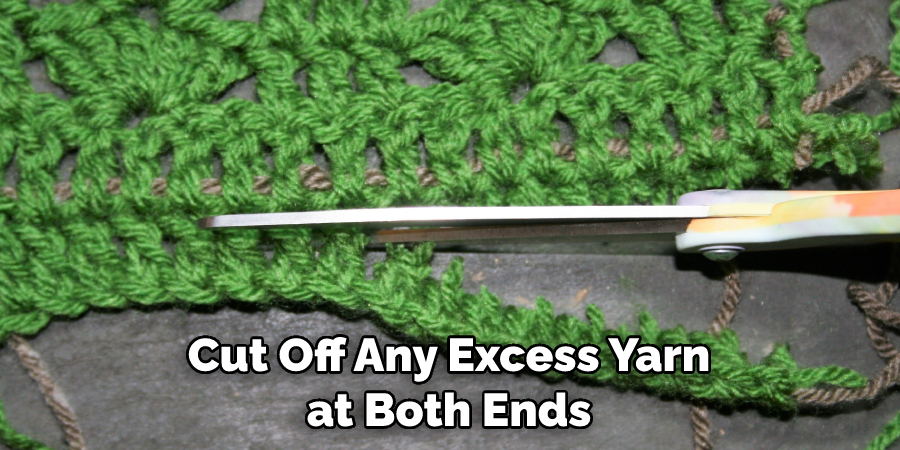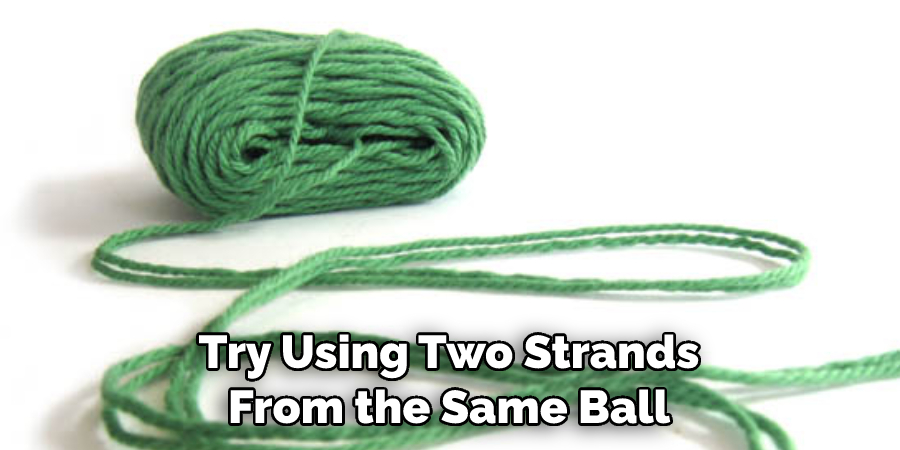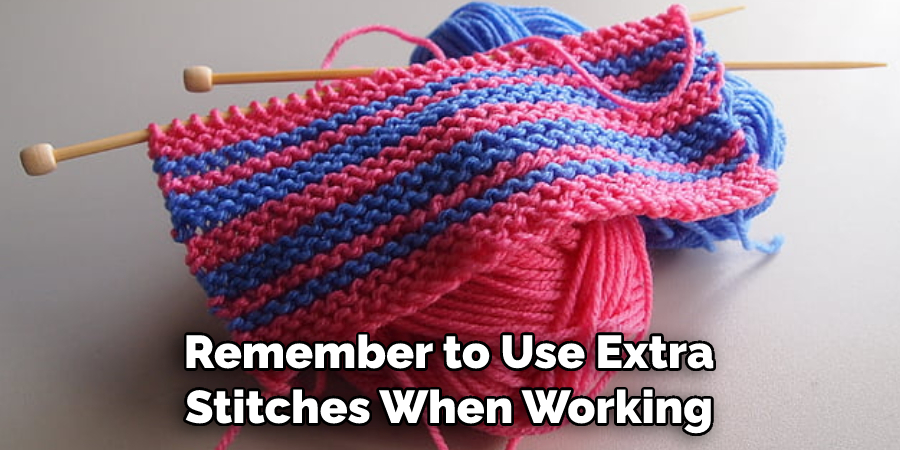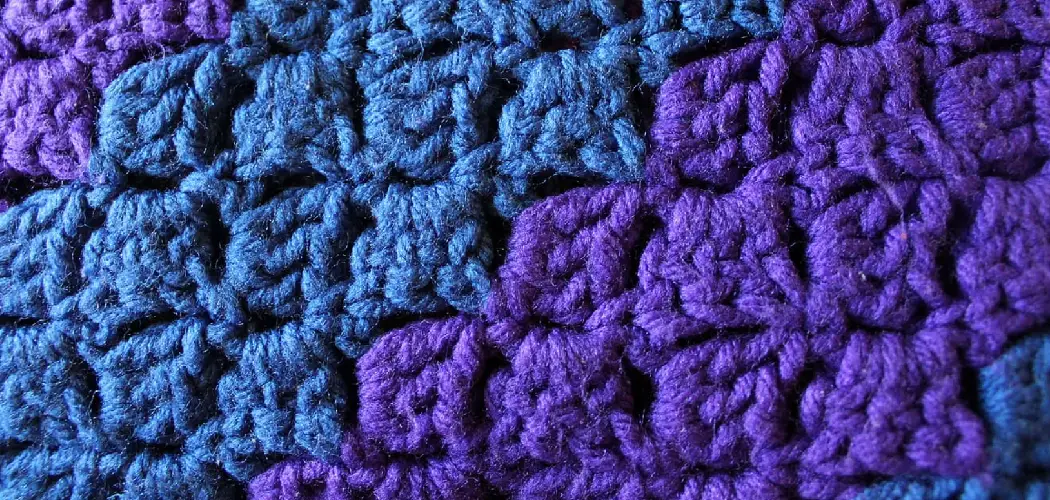Are you looking to spruce up a knitting project or craft item? Doubling up a yarn can easily and effectively add texture and color to any piece. Whether you’re crocheting something special, working on decorative weaving, or customizing clothing, doubling up yarn is the perfect solution for making your creation unique.

Maybe it’s so complicated that you thought it couldn’t be done on your own. Well, today is your lucky day! Here in this blog post, we will go through the step-by-step process of how to double up yarn to create a more robust and noticeable feature for your next crafting project. Plus, here are some tips and tricks that will ensure success in all your crafting endeavors.
Let’s explore what kind of amazing results you can create when you double your yarn!
What Will You Need?
Before you get started, make sure that you have the following items:
- Yarn in two different colors or types (cotton, wool, etc.)
- Needle and thread or a crochet hook
- Scissors
Once you have all of your supplies ready to go!
10 Easy Steps on How to Double Up Yarn
Step 1: Prepare the Yarn
Start by gathering the two strands of yarn together, ensuring that they are even in length. You may want to use a ruler or measuring tape to make sure that your two pieces are the same size. It is important that the lengths of both strands are as close as possible.
Step 2: Tie a Knot
Tie the two strands of yarn together near one end. Make sure to leave about 6 inches of loose yarn before knotting for ease of working later on. If you are having trouble tying the knot, use a needle and thread to secure it.
Step 3: Separate the Strands
Gently pull the two strands apart and separate them into different hands, so each strand is held in its own hand. This will provide good tension when you are weaving your pattern and make it easier to work with. Additionally, this will make it easier to switch colors.
Step 4: Begin Weaving Your Pattern
Carefully begin weaving your desired pattern using both strands and creating a tight weave (this can be done using a needle and thread or a crochet hook). Try to keep the tension even while weaving. Because you are working with two strands, it may take longer than usual to complete your pattern.
Step 5: Continue Weaving the Pattern
Continue weaving your desired pattern until you have reached your desired length. Don’t forget to keep the tension even throughout by working with both strands in each hand. If you find that this becomes too difficult, you may choose to use a crochet hook or needle and thread.
Step 6: Secure the End of Your Work
Once you’ve finished weaving, secure the end by knotting together both strands at the bottom. Make sure that it is tight and secure so it won’t come undone easily. Otherwise, you may choose to use a needle and thread to secure the end.
Step 7: Cut Off Any Excess Yarn
Cut off any excess yarn at both ends of your work, and make sure that they are even lengths. This will give your piece a clean finish and make it look more polished once it’s complete. Additionally, it will make it easier to sew the piece onto whatever item you are creating.

Step 8: Add Color or Texture to Your Work
If you want, you can use the extra yarn from before to add color or texture to your piece. You can either weave it in randomly for a more abstract look or incorporate it into your pattern for a more consistent effect. Don’t forget to secure the ends when you are done.
Step 9: Finish Up Your Piece
Go over your work one last time and make sure that everything is secure and looks how you want it. Once satisfied, tie off the end of the yarn one last time and cut the ends, so they are even lengths. You can also choose to use a needle and thread to secure the ends.
Step 10: Enjoy!
Now you can enjoy your finished project with its new doubled up yarn feature! The possibilities are endless when it comes to how you can use this technique, so don’t be afraid to get creative and make something truly unique. Remember to experiment and find which patterns you like the most.
By following these steps, you should have mastered double up yarn and created beautiful pieces of art with it. The possibilities are endless when it comes to how you can use this technique, so don’t be afraid to get creative and make something truly unique. Enjoy!
5 Additional Tips and Tricks
1. If you want to double up a large amount of yarn, consider using two separate balls instead; it will be much easier to work with this way.
2. To double up smaller amounts of yarn, try using two strands from the same ball; just pull gently from both sides and place them together on your hook or needle.
3. It is important to remember that when doubling up a strand of yarn, you should use twice as many stitches as normal so that the finished product looks even and consistent.
4. When combining two different colors of yarn for a project, ensure they are the same weight and fiber content to ensure an even result.

5. Don’t forget to test how the doubled-up yarn looks when worked up; it might be different than how it looks when held together in a strand! This will help you decide how to use the doubled yarn in your project best.
By following these tips, you should have all the knowledge and resources you need to double up yarn to create beautiful projects confidently.
5 Things You Should Avoid
1. Don’t mix different weights of yarn: Mixing different weights of yarn can lead to uneven loops and lumps in your knitting or crocheting project.
2. Avoid teasing the strands: Teasing the strands increases the risk of knots later on as you work with the doubled-up yarn, so it’s best to avoid it.
3. Don’t over twist: Over-twisting can cause your yarn to kink up and create a tangled mess that’s hard to work with.
4. Don’t pull too tight: Pulling too tight when you wrap the two strands together can result in an overly tight knot, which is difficult to unravel later on if needed.
5. Avoid looping back around itself: When you’re done wrapping, don’t loop the yarn back around itself, as this can create lumps or knots.
By following these tips when double-wrapping your yarn, you’ll be able to keep your knitting projects looking neat and uniform! With a little practice and patience, you’ll soon get the hang of double up yarn—happy crafting!
How Do You Start a Second Ball of Yarn?
1. Secure the end of the first ball: With your working yarn still attached to the outside of the ball, ensure you secure it, so it’s not loose and unwinding.
2. Attach the second ball: With both balls of yarn have been secured, join the two together by looping one strand around each other (like how you would do when wrapping a gift). You should be able to feel how tight or loose these wraps are, as this will affect how even your project looks at the end.
3. Start crocheting/knitting: Now that your doubled-up yarn is ready to go, start crocheting or knitting with them as if they were one strand! Remember to use extra stitches when working with the doubled-up yarn so that your project looks even and uniform.

4. Keep yarn balls separate: As you work, make sure to keep the two balls of yarn separate and not twisted—this will help create a consistent look for your project.
By following these steps, you should be able to start a second ball of yarn successfully. With a bit of practice, you’ll soon have no trouble double wrapping your yarn for any project!
Conclusion
All in all, doubling up your yarn is a great way to produce bigger, more durable projects. Whether it be to make heirloom-quality potholders or a thick crochet blanket, doubling your yarn can definitely help you create wonderful items that will last a lifetime.
Experimenting with different techniques and understanding the complexity of the process is a great skill set to have when it comes to working with yarn. Even if you don’t double up your regular skeins, learning how to use two strands of yarn together can open up many possibilities for creating awesome pieces of crafts.
Hopefully, the article on how to double up yarn and what to avoid has been informative and helpful. Now you can start working with two strands of yarn with confidence!
So get creative and see what amazing things you can make! Who knows – maybe one day you’ll be able to share your skills with others and help them make their own unique projects as delightful as yours.

